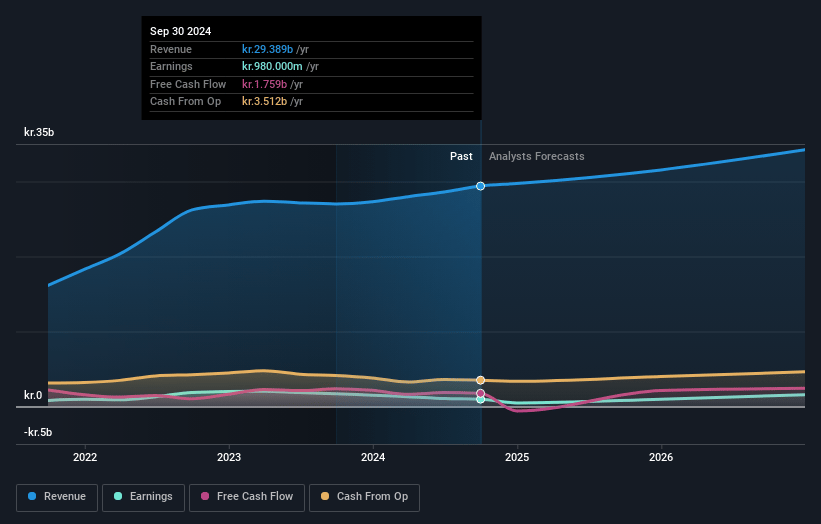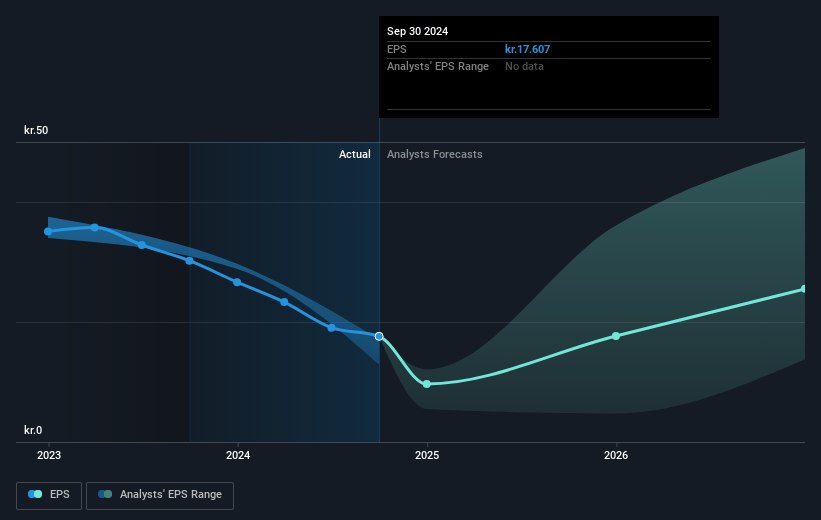Last Update01 May 25
Key Takeaways
- Strategic acquisitions and network initiatives, including Mediterranean competitive improvements and Logistics Boost, aim to drive organic growth and revenue by 2025.
- Efforts to deleverage and optimize the balance sheet through asset disposals and pricing strategies enhance financial stability and future margins.
- Competitive pressures, strategic missteps, and macroeconomic challenges threaten DFDS's financial stability, revenue growth, and sustainability goals, impacting earnings and margins.
Catalysts
About DFDS- Provides logistics solutions and services in Denmark and internationally.
- DFDS is focusing on unlocking value from its network with three main initiatives for 2025: improving the competitive situation in the Mediterranean ferry network, the turnaround of the recently acquired Turkish transport company, and advancing Logistics Boost projects. This should positively impact future revenue and earnings growth.
- The company expects organic revenue growth in 2025, supported by strategic acquisitions such as Ekol and Strait of Gibraltar, and a new 20-year concession with Jersey Islands, potentially leading to improved revenue streams.
- Rebalancing of capacity and improving pricing strategies in the Mediterranean market are expected to counteract competition pressures and enhance net margins in this region.
- Logistics Boost projects aim to address underperformance in Nordic and Continental logistics sectors, targeting specific operational improvements and strategic market adjustments, which could increase future earnings.
- Ongoing efforts to deleverage the balance sheet and maintain a strategic cash flow focus, including non-core asset disposals and working capital improvements, are expected to enhance financial stability, possibly improving net margins and earnings.
DFDS Future Earnings and Revenue Growth
Assumptions
How have these above catalysts been quantified?- Analysts are assuming DFDS's revenue will grow by 5.5% annually over the next 3 years.
- Analysts assume that profit margins will increase from 1.8% today to 2.5% in 3 years time.
- Analysts expect earnings to reach DKK 883.0 million (and earnings per share of DKK 16.33) by about May 2028, up from DKK 534.0 million today. The analysts are largely in agreement about this estimate.
- In order for the above numbers to justify the analysts price target, the company would need to trade at a PE ratio of 9.7x on those 2028 earnings, up from 9.2x today. This future PE is greater than the current PE for the GB Shipping industry at 5.9x.
- Analysts expect the number of shares outstanding to decline by 3.89% per year for the next 3 years.
- To value all of this in today's terms, we will use a discount rate of 9.94%, as per the Simply Wall St company report.
DFDS Future Earnings Per Share Growth
Risks
What could happen that would invalidate this narrative?- Significant competitive pressure in the Mediterranean, including overcapacity issues and a new competitor, could lead to lower utilization and pricing, impacting DFDS’s revenue and earnings.
- The acquisition of a loss-making Turkish transport company (Ekol) has yet to be fully turned around, which continues to negatively impact DFDS's earnings and overall financial stability.
- Increased leverage from recent acquisitions has placed DFDS at a higher financial risk, which could affect its ability to finance operations or make necessary investments, impacting net margins.
- Ongoing macroeconomic and market headwinds, especially effects from Brexit and geopolitical issues, are putting pressure on revenue growth and net margins in the Logistics division, particularly in the Nordic and European markets.
- Despite sustainability goals, challenging transitions to low-emission ships and infrastructure due to high costs and fuel availability could delay environmental targets and add financial strain, impacting overall earnings and margins.
Valuation
How have all the factors above been brought together to estimate a fair value?- The analysts have a consensus price target of DKK137.333 for DFDS based on their expectations of its future earnings growth, profit margins and other risk factors. However, there is a degree of disagreement amongst analysts, with the most bullish reporting a price target of DKK200.0, and the most bearish reporting a price target of just DKK91.0.
- In order for you to agree with the analyst's consensus, you'd need to believe that by 2028, revenues will be DKK35.0 billion, earnings will come to DKK883.0 million, and it would be trading on a PE ratio of 9.7x, assuming you use a discount rate of 9.9%.
- Given the current share price of DKK91.3, the analyst price target of DKK137.33 is 33.5% higher.
- We always encourage you to reach your own conclusions though. So sense check these analyst numbers against your own assumptions and expectations based on your understanding of the business and what you believe is probable.
How well do narratives help inform your perspective?
Disclaimer
AnalystConsensusTarget is a tool utilizing a Large Language Model (LLM) that ingests data on consensus price targets, forecasted revenue and earnings figures, as well as the transcripts of earnings calls to produce qualitative analysis. The narratives produced by AnalystConsensusTarget are general in nature and are based solely on analyst data and publicly-available material published by the respective companies. These scenarios are not indicative of the company's future performance and are exploratory in nature. Simply Wall St has no position in the company(s) mentioned. Simply Wall St may provide the securities issuer or related entities with website advertising services for a fee, on an arm's length basis. These relationships have no impact on the way we conduct our business, the content we host, or how our content is served to users. The price targets and estimates used are consensus data, and do not constitute a recommendation to buy or sell any stock, and they do not take account of your objectives, or your financial situation. Note that AnalystConsensusTarget's analysis may not factor in the latest price-sensitive company announcements or qualitative material.






